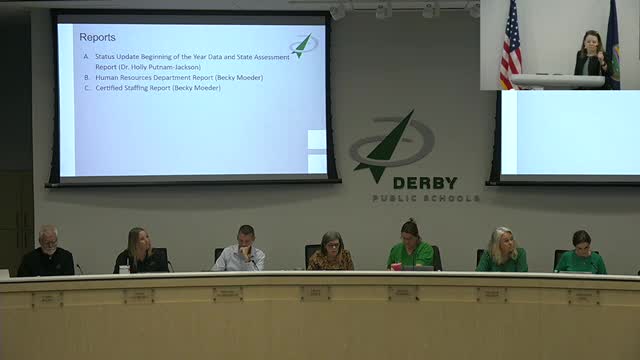Board hears start-of-year assessment data; district staff urge patience on long-term curriculum effects
October 13, 2025 | Derby, Sedgwick County, Kansas
This article was created by AI summarizing key points discussed. AI makes mistakes, so for full details and context, please refer to the video of the full meeting. Please report any errors so we can fix them. Report an error »

Assistant Superintendent Holly Putnam Jackson presented a beginning-of-year data and state assessment report on Oct. 13, outlining early results from district screening tools (Ready Reading and Ready Math), the new Kansas state assessment levels, and comparisons with state and national norms.
Putnam Jackson said district elementary third graders scored higher than the state average on the new Kansas assessment, with about 57% of Derby students at the top two performance levels compared with a 53% state average; district students were also less likely to score in the lowest level (21% vs. the state's 26%). She highlighted strong math results for the district's eighth graders, who scored at 50% proficiency on the state math assessment compared with a 39% state average, and higher science proficiency in grades 5 and 11.
Nut graf: District leaders urged the board to interpret early-year screening results cautiously. Putnam Jackson said some programs and curricular changes require multiple years of implementation before they show steady effects, citing "implementation science" timelines of roughly four to seven years for large shifts.
Board members asked for longitudinal cohort data and for school-level trend lines to support budget and program decisions. Putnam Jackson said the district can provide more longitudinal information where available: Ready Math data extends roughly four to five years, some local tools have two to three years, but the new state assessment re-norming limits long-term comparability for this first year.
Other discussion included how to use assessment results in secondary scheduling and interventions; staff noted options such as daily reading labs, targeted interventions (tier 2/tier 3), tutoring, and counselor/teacher recommendations for supports. Several board members raised concerns about test fatigue among students and the balance between assessment and instruction.
Ending: Putnam Jackson and board members said the district will continue to triangulate data (local assessment scores, classroom grades and state tests), provide more cohort trend data where possible, and watch multi-year trajectories before making major instructional changes.
Putnam Jackson said district elementary third graders scored higher than the state average on the new Kansas assessment, with about 57% of Derby students at the top two performance levels compared with a 53% state average; district students were also less likely to score in the lowest level (21% vs. the state's 26%). She highlighted strong math results for the district's eighth graders, who scored at 50% proficiency on the state math assessment compared with a 39% state average, and higher science proficiency in grades 5 and 11.
Nut graf: District leaders urged the board to interpret early-year screening results cautiously. Putnam Jackson said some programs and curricular changes require multiple years of implementation before they show steady effects, citing "implementation science" timelines of roughly four to seven years for large shifts.
Board members asked for longitudinal cohort data and for school-level trend lines to support budget and program decisions. Putnam Jackson said the district can provide more longitudinal information where available: Ready Math data extends roughly four to five years, some local tools have two to three years, but the new state assessment re-norming limits long-term comparability for this first year.
Other discussion included how to use assessment results in secondary scheduling and interventions; staff noted options such as daily reading labs, targeted interventions (tier 2/tier 3), tutoring, and counselor/teacher recommendations for supports. Several board members raised concerns about test fatigue among students and the balance between assessment and instruction.
Ending: Putnam Jackson and board members said the district will continue to triangulate data (local assessment scores, classroom grades and state tests), provide more cohort trend data where possible, and watch multi-year trajectories before making major instructional changes.
View the Full Meeting & All Its Details
This article offers just a summary. Unlock complete video, transcripts, and insights as a Founder Member.
✓
Watch full, unedited meeting videos
✓
Search every word spoken in unlimited transcripts
✓
AI summaries & real-time alerts (all government levels)
✓
Permanent access to expanding government content
30-day money-back guarantee

